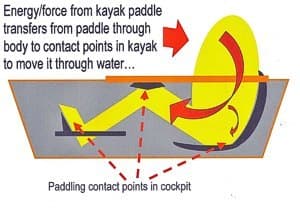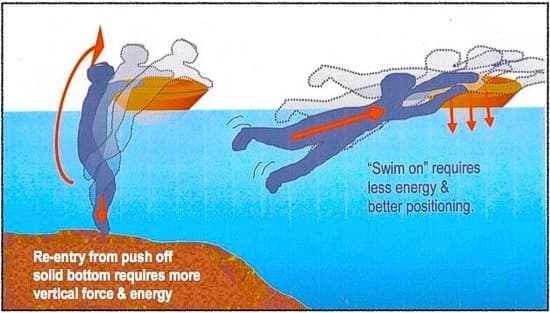A Kayaker's Body English
Technically speaking, Webster's defines "Body English" as: the bodily motions made in a usually unconscious effort to influence the progress of a propelled object. In kayaking, our efforts are quite "conscious" when we use our body language in response to what our boat is doing - and equally important - when we want our boat to respond to us.
Let's take a look as some basic paddling and boat handling techniques and maneuvers in this vocabulary of 'kayak speak' - our paddling Body English (BE).
The most fundamental Body English we use is, indeed, subconcious for the most part as we simple maintain our 'balance' as we sit in the kayak. As the situation becomes 'tippier" we automatically make adjustments with our body to maintain balance. As we engage in deliberate leaning maneuvers, shifting our body into a "J" re-positions our center of gravity in the kayak as it leans. This keeps you upright while initiating steeper turns or countering shifts in the boat's balance and Center of Buoyancy.

Torso Rotation is perhaps the most fundamental body movements taught to beginning paddlers. Since we, as paddlers, provide the driving force that propels our craft through the water, we want to do so as efficiently as we can - optimizing our stroke while minimizing our effort. Too often paddlers use only their arms to provide that force. By rotating our torso we extend the reach of our paddle, spreading that effort out into our shoulders/torso and stomach muscles. Our 'BE' becomes a physical conversation that affects how effectively we propel ourselves along the surface.
In order to get the most out of this torso rotation, our body needs to be carrying on several conversations with our boat at all times. Proper body contact while seated means we are speaking to different parts of the cockpit at the same time.
Like any formal "speech", good posture makes for a better presentation. Slouching in a kayak is like slumping over the lectern while giving a formal talk. Our torso twist will be more effective if we are properly positioned while seated.
TAHE 10'6 & 11'6 SUP-YAK Inflatables
2-in-1 Kayak & Paddle Board complete packages for single or tandem use.

Your paddle enables you to move your boat through the water. That force travels up the shaft, through your body and out along the boat, moving it in response to those external forces. You body provides several contact points for that transfer of force to occur.
Technically we should refer to that vertical portion of our kayak seat as a seat back, and not a back 'rest'. It's not something to slump down against while paddling, but a structure against which you help your body transfer some of that paddling force down to your boat.
Other important contact points between your body and the kayak are your knees and feet. Oftentimes when paddlers don't use foot braces their bodies talk back to them in the form of a sore back because that force wasn't distributed proportionately beyond your knees to your lower extremities, but excessively out through the lower back and hips.
Another area where you use BE to speak to your boat is your paddle stroke style. High strokers tend to use shorter paddles with larger blades, held more vertically and stroked closer along the gunwales of the kayak. The high position is a power stroke.
A lower or 'touring' stroke usually incorporates a longer paddle with a narrower blade. It's a more casual stroke. In both cases, our BE reflects either a harsh command for a burst of speed or a casual comment to initiate a gentle maneuvering sweep.

Even our paddling grip benefits from our command of Body English. Whether you alter your blade angles or paddle unfeathered, your power grip and your return stroke hand are affected by BE. Your hands are like ears listening to what the paddle is saying. Your grip also passes along your message down the shaft. You're a cowboy speaking to his horse through the reins in your hands.
Alternately, you are guiding the opposite side of the paddle through an arc that will put it into position for the power stroke on that side of the boat. That hand can be more relaxed, your grip more at ease as you rest before the power stroke re-grip.
Instead of wrapping your fingers tightly around the shaft, you can carry on a light conversation of BE by opening your fingers, directing that forward motion along your arm and into the shaft cradled in the "V" at the base of your index finger and thumb. You can also take command of this "conversation" by closing your finger/thumb tip into an "O", ready to tighten into a grip at a moment's whisper.

Sometimes your boat will speak to you: "My front end's too heavy" or "I want to turn into the wind". Learning to properly pack and trim your boat will hopefully soon end that first chat. Learning to shift your center of gravity to compensate poor trim may be an ongoing conversation as your boats or gear change.
Still some boats, by design or otherwise, may tend to want to veer off your desired course. Typically turning into the wind (weathercocking) is the most common characteristic we want/need to correct when paddling. And while we can use a rudder or skeg to help offset that tendency to turn upwind, we can use our BE to pursuade our boat to stay on course.
Not wanting to get into all the dynamics of flow and pressure along the hull, wind from the side can cause a kayak to want to turn into that wind…cock towards the "weather" side (as opposed to the lee side) - thus weathercocking. Powerful or sweeping strokes on the windward side of the kayak can muscle the boat back on course. Using BE can also help you maintain a more regular paddling cadence while keeping your boat heading where you want it.
Basically if you alter the waterline of your boat (leaning the hull changes that footprint at the water's surface), your boat responds by turning opposite that lean. One way to maintain that lean is to use a knee lift that raises the downwind side of the kayak. By altering your position (assuming the "J" position) you can counter the turn of the weathercocking by the opposite turn from the lean - basically cancelling each other out and maintaining a straight course.
This "feel" for your boat helps you tell your kayak what to do. It also helps you respond when your boat starts telling you what it is doing as well.

Another area where your body's position can help you achieve a more efficient execution of a technique or maneuver is a deep-water re-entry into your kayak. So often rescue techniques are taught in the controlled tameness of a swimming pool. In addition to the passive calmness of the water, rescues are often performed in shallow water where participants use the bottom of the pool as a platform to attempt to literally jump up into their boats. This is both impractically and unrealistic.
In deep water "jumping" up into your boat requires an incredible amount of exertion and tends to pull the boat over and downward. And with no footing, most of your effective power will have to come from your arms - all a very tiring and energy-draining effort.
It's generally better to extend your body out along the surface, perpendicular to your boat and using a swimmer's kicking motion to literally swim up onto your boat, carefully timing a downward thrust onto the deck as you swim up onto its surface. It's a form of Body English that shouts out a more effective way of re-entering your boat after a capsize.

Like all techniques, using Body English offers a high, but not perfect, level of success in achieving more efficient paddling. Techniques are usually inter-related and to some degree dependent upon doing something else correctly or most efficiently (using a touring stroke to relax when your poor posture and lack of torso rotation creates fatigue is counter productive). Using Body English often becomes a subconscious effort as we become more proficient in our paddling…and what we hear our boat telling us and what we "say" back to it.
Be Safe, Have fun out there!
Additional resources:
"The Essential Sea Kayaker" by David Seidman
"The Complete Sea Kayaker's Handbook" by Shelly Johnson
Tom Watson is an avid sea kayaker and freelance writer. For more of Tom's paddling tips and gear reviews go to his website: www.wavetameradventures.com. He has written 2 books, "Kids Gone Paddlin" and "How to Think Like A Survivor" that are available on Amazon.com.
Related Articles
Kyla, my 10-year-old, took position in the stern on our last canoe trip. Her friend, who tagged along,…
It propels us in a straight line. Although it may be the stroke we do 95% of the time to get around, it…
Eddy turns are the foundation for paddling in current, enabling you to enter and exit river and tidal…
This video describes the bracing stroke for your stand up board and will help you learn to stand on your…


